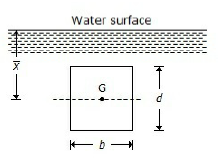The centre of gravity of the volume of the liquid displaced is called
Centre of pressure
Centre of buoyancy
Metacentre
None of these
Correct Answer :
B. Centre of buoyancy
Related Questions
The pressure in Pascals at a depth of 1 m below the free surface of a body of water will be equal to
1 Pa
91 Pa
981 Pa
9810 Pa
The viscosity of water is __________ than that of mercury.
Higher
Lower
Same as
None of these
The property of a liquid which offers resistance to the movement of one layer of liquid over another adjacent layer of liquid, is called
Surface tension
Compressibility
Capillarity
Viscosity
A vertically immersed surface is shown in the below figure. The distance of its centre of pressure from the water surface is 
(bd²/12) + x
(d²/12 x) + x
b²/12 + x
d²/12 + x
Ratio of inertia force to elastic force is known as
Mach number
Froude number
Reynolds number
Weber's number
A submerged body is said to be in a stable equilibrium, if its centre of gravity __________ the centre of buoyancy.
Coincides with
Lies below
Lies above
None of these
Reynold's number is the ratio of the inertia force to the
Surface tension force
Viscous force
Gravity force
Elastic force
Water is a __________ fluid.
Real
Ideal
Newtonian
Non-Newtonian
The viscosity of water at 20°C is
One stoke
One centistoke
One poise
One centipoise
Kinematic viscosity is equal to
Dynamic viscosity/density
Dynamic viscosity × density
Density/dynamic viscosity
1/dynamic viscosity × density
If the depth of water in an open channel is less than the critical depth, the flow is called
Critical flow
Turbulent flow
Tranquil flow
Torrential flow
Rain drops are spherical because of
Viscosity
Air resistance
Surface tension forces
Atmospheric pressure
Coefficient of velocity is defined as the ratio of
Actual velocity of jet at vena contracta to the theoretical velocity
Area of jet at vena contracta to the area of orifice
Actual discharge through an orifice to the theoretical discharge
None of the above
When a body is placed over a liquid, it will sink down if
Gravitational force is equal to the up-thrust of the liquid
Gravitational force is less than the up-thrust of the liquid
Gravitational force is more than the up-thrust of the liquid
None of the above
An error of 1% in measuring head over the apex of the notch (H) will produce an error of _________ in discharge over a triangular notch.
1 %
1.5 %
2 %
2.5 %
Bernoulli's equation is applied to
Venturimeter
Orifice meter
Pitot tube
All of these
According to Chezy's formula, the discharge through an open channel is (where A = Area of flow, C = Chezy's constant, m = Hydraulic mean depth, and i = Uniform slope in bed)
A × √(m × i)
C × √(m × i)
AC × √(m × i)
mi × √(A × C)
The water pressure per metre length on a vertical masonry wall of dam is (where w = Specific weight of the liquid, and H = Height of the liquid)
wH/2
wH
wH2/2
wH2/4
A thick liquid like syrup has a __________ viscosity than a light liquid like water.
Lesser
Greater
Same
None of these
Kinematic viscosity is dependent upon
Pressure
Distance
Density
Flow
If w is the specific weight of liquid and k the depth of any point from the surface, then pressure intensity at that point will be
h
wh
w/h
h/w
The atmospheric pressure with rise in altitude decreases
Linearly
First slowly and then steeply
First steeply and then gradually
Unpredictable
All the terms of energy in Bernoulli's equation have dimension of
Energy
Work
Mass
Length
The bulk modulus of elasticity with increase in pressure
Increases
Decreases
Remain constant
Increases first up to certain limit and then decreases
Select the correct statement
Weber's number is the ratio of inertia force to elastic force.
Weber's number is the ratio of gravity force to surface tension force.
Weber's number is the ratio of viscous force to pressure force.
Weber's number is the ratio of inertia force to surface tension force.
The resultant upward pressure of the fluid on an immersed body is called
Up-thrust
Buoyancy
Center of pressure
All the above are correct
According to Francis formula, the discharge over a rectangular weir is (where n = Number of end contractions)
(2/3) × Cd (L - nH) × √(2gh)
(2/3) × Cd (L - 0.1nH) × √(2g) × H3/2
(2/3) × Cd (L - nH) × √(2g) × H²
(2/3) × Cd (L - nH) × √(2g) × H5/2
A piece of wood having weight 5 kg floats in water with 60% of its volume under the liquid. The specific gravity of wood is
0.83
0.6
0.4
0.3
The power transmitted through a pipe is (where w = Specific weight in N/m3, and Q = Discharge in m3/s)
w × Q × H
w × Q × hf
w × Q (H - hf)
w × Q (H + hf)
The total energy of each particle at various places in the case of perfect incompressible fluid flowing in continuous stream
Keeps on increasing
Keeps on decreasing
Remain constant
May increase/decrease
